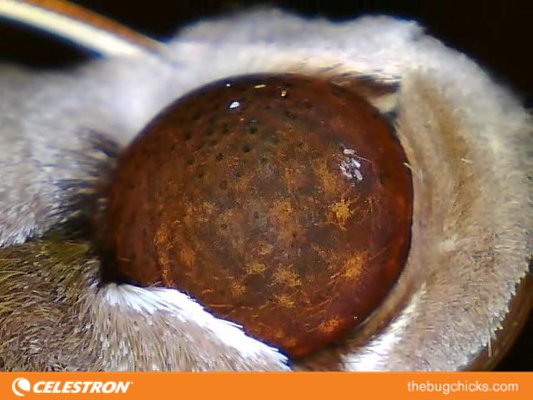Insects, Phototaxis and the Dark
It's the last day to post a photo to social media and tag Celestron for their #ChangeYourView2015 November Nights contest! Wow- November flew by. Speaking of flying--
Have you ever wondered why insects are attracted to your porch light at night? It bewilders people. Why, if this insect is nocturnal and only flies at night, does it get mesmerized by the light to the point where it seems like it can't fly away?
The response to light that some insects experience is called phototaxis. This means that the whole body of the organism will move toward or away from light. Moths are the classic example; they are positively phototactic. Cockroaches, however, are negatively phototactic. Humans have introduced such intense light pollution that insects are now confused as they migrate or try to find food. Moths have eyes that are incredibly good at collecting light and not reflecting it back. They are incredibly drawn to the light.
But why light? Insects use light to guide their way through the world. For one thing, they don't "see" the world in the same light spectrum that we do. A lot of insects see better in UV light.
In the video below, go to the 00:43 second mark to get a feel for how the world looks to an insect!
They will also track their own movements based on a fixed point of light- like the sun if they are diurnal, or the moon and stars if they are nocturnal. For example, there are dung beetles that navigate by the moon and the stars as they roll their balls of dung. But the moon is kind of fickle right? It's not always there. Scientist Eric Warrant and his team at Lund University have figured out that these nocturnal dung beetles may use polarized light (moonlight scattered in the atmosphere) or even the Milky Way to navigate! Without it, beetles will roll their dung balls in never-ending circles. It seems that the Milky Way helps the dung beetles to move in a straight line.
**If you want to see some incredible astroimaging pictures, I suggest you check out John Davis' page on Team Celestron. #ScopeLove!
In some ways, human-introduced light can be a benefit- predators will hang out by lights and take their pick of phototactic insects that are drawn there. Entomologists also use light traps. We set them up in dark areas of forest or fields and use different wavelengths of light to attract different kinds of arthropods we would like to collect. It's fun, when traveling overseas to turn on a light once you're in your mosquito net, to see what lives in the room with you!
Expert tip: When I'm camping, people always ask me how I don't get irritated by bugs flying in my face when I have my headlamp on. I tell them to use a red light! It's great for keeping your sensitive low-light vision intact and also bugs don't see the red wavelength, so they won't be attracted to it. I use my red light to sneak up on spiders and watch them without scaring them away. We all have our quirks.


